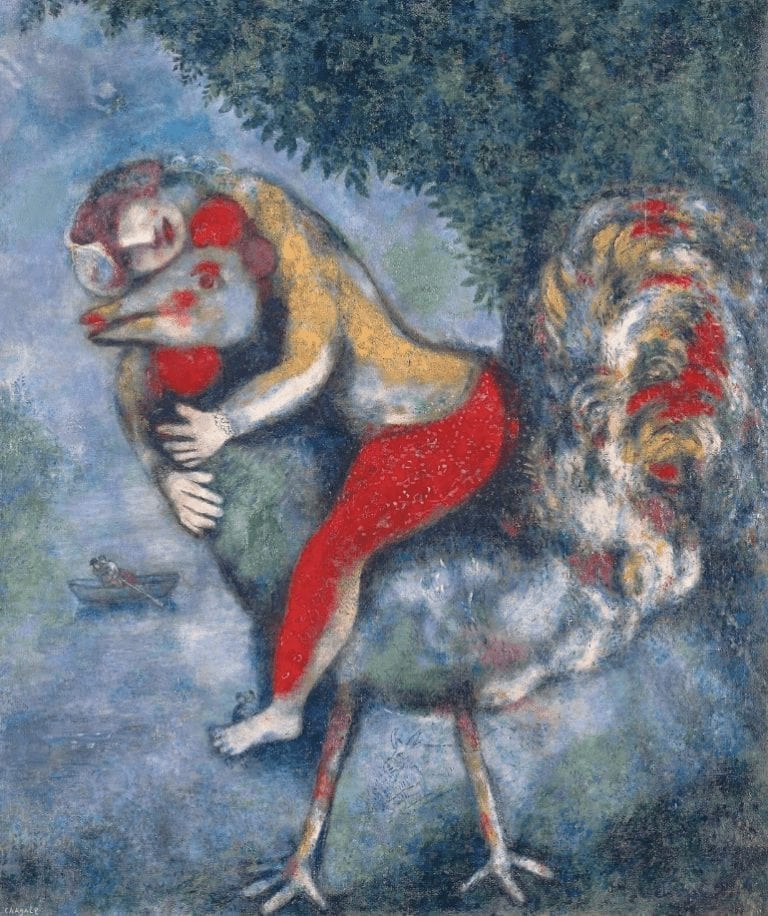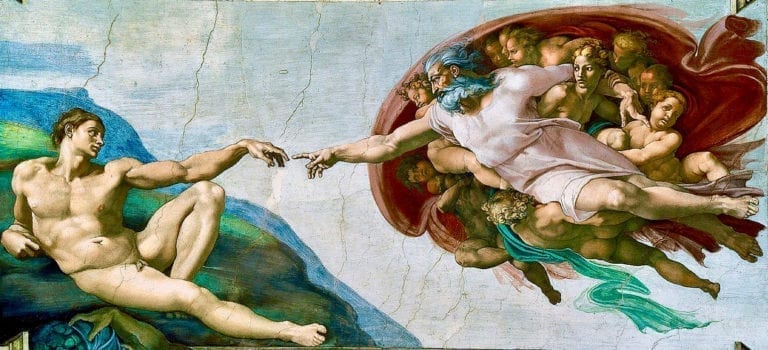Marc Chagall’s magical paintings evoke dreams and other worldy love. So, it’s no surprise many, like The Rooster, get misinterpreted. Love serves as the ultimate mystery of human life. Chagall’s paintings show a childlike point of view. This reminds viewers, love brings out the kid in us. Like this one, my personal fav by Marc Chagall, The Rooster. At first glance, it could portray a carousel carnival ride. Love sometimes feels like that, with strange pairings going up and down in circles.
Many Chagall paintings share this dreamy quality. Sometimes it’s even childlike. His subjects bend and twist unlike real beings. They share a surreal vision that draws the viewer into another time and place. Falling into paintings such as this can open your mind if you let it. Like a game of free association, it arouses whimsy. The Rooster means one thing in a farmyard or coop. But tangible reality’s left behind in a Chagall.
A cock plays a certain role in the chicken coop. He’s in charge. But this one’s dominated. Chagall gives this Rooster the title role in more than just naming the piece. He takes up most of the canvas. So, although submissive, The Rooster still plays a main character here. It’s a painting about love. Big love. This bird seems to be bursting with it. He struts with a proud tail flourish. No doubt thanks to the warm embrace about his neck.
Even though it’s a fresh young take on love, this painting resonates deep. It only appears to be simple. The bird has that effect. He’s almost silly at that elephantine size. After all, a rooster you can ride makes this feel like an amusement park. It’s got a jubilance thanks to that. Love flows through this work like the lake water in its background. It’s almost imperceptible yet still undeniable.
For an audio version of this post click below:
Marc Chagall, The Rooster reminds us that love comes in many forms. It’s easy to conclude that the work’s three pairs of lovers signify the different types of love. One could read the centerpiece rooster as hot-to-trot flamboyance. Or the viewer could zoom in on the cuddling couple in the boat and project all sorts of salacious stories on them. There’s also the tiny pair peeking out from behind the lady’s foot. Our feet are such a familiar and intimate part of us. Perhaps these two perched upon one signify familial love.
The Rooster – Not Just a Cock
In fact, many art historians believe the rooster and lady are a sexual union of sorts. But this couple actually shows us the ultimate supportive relationship. Even if she mounts the cock in a meaningful manner, it’s not only about mere sex. The Rooster carries his lady while she gives him a luscious embrace. It’s a warm portrait of enduring love. The smile on her face is pure happiness, not just sexual ecstasy. This lasts longer than date night and satisfies on a deeper level. It’s real love. Sex plays a role in such relationships. However, it’s not even close to the whole story in the most significant ones.
Marc Chagall – Factoids
- Russian-French painter Marc Chagall was born on July 7, 1887, in Vitebsk, Russia.
- His painting La Mariée, French for The Bride, played a pivotal role in the movie Notting Hill.
- Chagall studied painting at an elite art school in Russia.
- But it was Paris that inspired his best work, including The Rooster.
- That’s where he fell in love with Fauvism and Cubism.
- Marc Chagall’s work provides a perfect example of Expressionism.
- His work conveys emotion with moving and surprising technique.
ENJOYED THIS The Rooster ANALYSIS?
Check out these other essays on French Painters.

